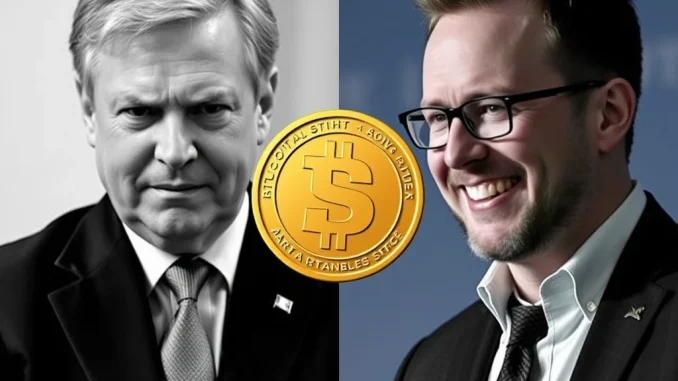
The cryptocurrency world is buzzing with discussions about stablecoins, and a key point of contention is whether these digital assets should generate interest for their holders. Recently, French Hill, a prominent figure in U.S. financial regulation, has stirred the pot by stating that there’s no consensus on allowing interest on stablecoins. This revelation has sparked a significant debate, especially clashing with the views of crypto industry leaders like Coinbase CEO Brian Armstrong. Let’s dive into this developing story and understand what it means for the future of stablecoins and your crypto holdings.
Why the Debate on Interest on Stablecoins?
Before we delve into French Hill’s statements, it’s crucial to understand why the concept of interest on stablecoins is even a topic of discussion. Stablecoins, unlike volatile cryptocurrencies like Bitcoin or Ethereum, are designed to maintain a stable value, typically pegged to a fiat currency like the US dollar. This stability makes them attractive for various use cases, from everyday transactions to a safe haven in the crypto market.
The idea of earning interest on stablecoins stems from the desire to make these assets even more appealing. If you can hold a digital dollar equivalent and earn a yield, it becomes a compelling alternative to traditional savings accounts, especially in a low-interest-rate environment. Platforms like Coinbase and others have explored and, in some cases, offered ways for users to earn rewards on their stablecoin holdings. This is where the regulatory friction comes in.
French Hill’s Stance: Stablecoins as Payments, Not Investments
 French Hill, Chairman of the U.S. House Financial Services Committee
French Hill, Chairman of the U.S. House Financial Services Committee
French Hill, as chairman of the U.S. House Financial Services Committee, holds a significant position in shaping financial regulations. His recent statement, as reported by Decrypt, clearly indicates a cautious approach towards interest on stablecoins. According to Hill, there’s a bipartisan agreement in the U.S. Congress that stablecoins should primarily function as a means of payment. This perspective frames stablecoins as tools for facilitating transactions, similar to digital cash, rather than investment vehicles designed to generate profit.
Here are the key takeaways from French Hill’s statement:
- No Consensus on Interest: Hill explicitly stated that there is no widespread agreement in Congress to allow dollar-collateralized stablecoins to pay interest to holders.
- Payment Mechanism Focus: The prevailing view in Congress is that stablecoins should be regulated and utilized as a payment system, not as investment products.
- Bipartisan Agreement: Hill suggests that this stance is not limited to one political party, indicating a broader consensus across the political spectrum in the U.S.
Coinbase CEO Brian Armstrong’s Counter-Argument: Unlocking Potential with Crypto Yield
 Brian Armstrong, CEO of Coinbase
Brian Armstrong, CEO of Coinbase
In stark contrast to French Hill’s viewpoint, Coinbase CEO Brian Armstrong has been a vocal advocate for allowing consumers to earn interest on stablecoins. Armstrong argues that the U.S. should establish clear stablecoin legislation that permits this practice. His argument is rooted in the belief that stablecoins, and the broader cryptocurrency ecosystem, can offer innovative financial services and opportunities to consumers.
Armstrong’s perspective emphasizes the potential benefits of cryptocurrency regulation that embraces innovation:
- Consumer Benefits: Allowing interest on stablecoins could provide consumers with new avenues for earning yield on their digital assets, potentially outperforming traditional savings options.
- Innovation and Growth: Permissive regulations could foster innovation within the stablecoin market and the wider crypto industry, encouraging growth and adoption.
- Global Competitiveness: Armstrong likely believes that a forward-thinking approach to stablecoin regulation would position the U.S. as a leader in the global digital economy.
The Regulatory Maze: Navigating the Path for Stablecoin Growth
The differing opinions of French Hill and Brian Armstrong highlight the complex regulatory landscape surrounding cryptocurrency regulation, specifically for stablecoins. The core issue revolves around how regulators classify and treat stablecoins – are they primarily payment tools, investment products, or something in between?
Here’s a breakdown of the key regulatory considerations:
| Regulatory Aspect | Payment Tool Perspective (Hill’s View) | Investment Product Perspective (Armstrong’s View) |
|---|---|---|
| Primary Function | Facilitating transactions, digital cash alternative | Yield generation, asset appreciation potential |
| Regulatory Focus | Payment system oversight, consumer protection in transactions | Securities regulations, investor protection, disclosure requirements |
| Interest/Yield | Generally discouraged, potential regulatory hurdles | Permitted and potentially encouraged with appropriate frameworks |
| Impact on Innovation | Potentially limits innovation in yield-generating stablecoin products | Encourages innovation and development of new financial products |
Challenges and Opportunities in Stablecoin Regulation
The debate surrounding stablecoins and interest on stablecoins is not just about technicalities; it touches upon fundamental questions about the future of finance. Regulators face the challenge of balancing consumer protection and financial stability with fostering innovation in the rapidly evolving crypto space.
Challenges:
- Defining Stablecoin Classification: Determining the precise regulatory category for stablecoins is crucial. Are they currencies, securities, or something else entirely? This classification dictates the applicable regulatory framework.
- Investor Protection: If stablecoins are treated as investment products, robust investor protection mechanisms are necessary to safeguard consumers from risks associated with yield-generating activities.
- Systemic Risk: The rapid growth of stablecoins raises concerns about potential systemic risks to the broader financial system, particularly if they become widely adopted and interconnected with traditional finance.
- Global Regulatory Coordination: Given the borderless nature of cryptocurrencies, international regulatory coordination is essential to prevent regulatory arbitrage and ensure consistent standards.
Opportunities:
- Financial Inclusion: Stablecoins and interest on stablecoins could potentially enhance financial inclusion by providing access to yield-generating opportunities for underserved populations.
- Payment System Efficiency: Stablecoins can streamline payment processes, reduce transaction costs, and improve the efficiency of financial systems.
- Innovation Hub: A well-defined and balanced regulatory framework can position the U.S. as a hub for cryptocurrency innovation, attracting investment and talent.
- Economic Growth: By fostering responsible innovation in the crypto space, regulators can contribute to economic growth and create new opportunities in the digital economy.
Actionable Insights: Staying Ahead in the Stablecoin Space
For anyone involved or interested in cryptocurrencies, particularly stablecoins, staying informed about regulatory developments is paramount. Here are some actionable insights:
- Follow Regulatory News: Keep a close watch on statements and actions from regulatory bodies like the U.S. House Financial Services Committee, the SEC, and other relevant agencies.
- Engage with Industry Discussions: Participate in online forums, industry events, and social media discussions to understand the evolving perspectives on stablecoin regulation.
- Assess Platform Risks: If you are using platforms that offer yield on stablecoins, carefully assess the risks involved and understand the regulatory status of these services.
- Advocate for Clear Regulation: If you believe in the potential of stablecoins and interest on stablecoins, consider engaging with policymakers and industry groups to advocate for clear and balanced regulations.
Conclusion: The Unfolding Story of Stablecoin Regulation
The contrasting views of French Hill and Brian Armstrong underscore the ongoing debate and uncertainty surrounding the regulatory future of stablecoins, especially concerning interest on stablecoins. While some policymakers lean towards treating stablecoins primarily as payment mechanisms, others see their potential as innovative financial instruments that could benefit consumers and drive economic growth. The path forward will likely involve continued dialogue, collaboration between regulators and industry players, and a careful balancing act between fostering innovation and mitigating risks. As this story unfolds, one thing is certain: the regulatory landscape for stablecoins will significantly shape the future of the cryptocurrency ecosystem and its integration with the traditional financial world. Stay tuned for further developments in this crucial area of cryptocurrency regulation.



